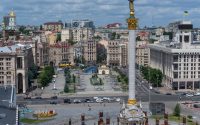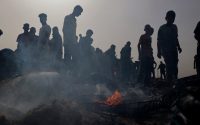Maps Show Scarce Shelter and Medical Care as Rafah Operation Is Underway
Hundreds of thousands of Gazans have fled the southern region of Rafah over the past week, after Israel has expanded its evacuation orders amid continued bombardment and fierce fighting there. Many Gazans, already displaced multiple times, are packing up makeshift tents and moving out of the area.
Encampments in eastern Rafah have emptied since a May 6 evacuation order
Source: Satellite image from Planet Labs
By The New York Times
Many Palestinians have been directed to an area along the coast designated by the Israelis as a “humanitarian zone.” Maps and analysis of satellite imagery show that the zone is already overcrowded, frequently damaged by strikes, and lacking sufficient medical services.
For months, Israel has threatened a full-scale invasion of Rafah to target Hamas, despite warnings from humanitarian officials, as well as its own allies, about the potential catastrophic toll on civilians. Israel has been conducting military operations in eastern Rafah since last week, describing them as “limited,” though it has stepped up pressure in recent days.
Health officials have said that dozens of Gazans have been killed by Israeli strikes in Rafah since May 6, and the United Nations reported that one of its workers had also died, the first international U.N. staff member killed since the war began.
The United Nations estimated on Tuesday that some 450,000 people had fled Rafah.
Where people were sheltering before military operations began last week
Tents had been concentrated in open areas in densely populated Rafah and near the coast. Many other areas in the declared safe zone had been heavily damaged.
Source: Satellite data from Planet Labs; Satellite image by Copernicus
Note: Tents observed in imagery as of May 5.
By The New York Times
Before the war, Rafah was home to fewer than 300,000 people. After the Hamas-led Oct. 7 attacks, Israel launched an offensive aimed at dismantling the group. The fighting forced more than two million Gazans to flee their homes, with many eventually ending up in Rafah.
Now, however, Rafah has become a focal point of Israel’s campaign. Its military has often struck areas in Rafah, killing people and damaging buildings.
Israel has said that Rafah is the last stronghold of Hamas, with several battalions holed up in tunnels below the city.
Last week, Israel seized the Gazan side of the Rafah border crossing with Egypt after Hamas fired rockets from the area and killed four Israeli soldiers.
Satellite imagery taken after the May 6 incursion shows extensive new damage to eastern parts of Rafah. From May 5 to May 7 alone, more than 400 structures were destroyed in the evacuation area, an analysis of satellite imagery by The New York Times found. Humanitarian workers say these areas also likely contain unexploded ordnances from the war.
Hundreds of Rafah buildings have been damaged recently, adding to the destruction
Sources: Damage analysis of Copernicus Sentinel-1 satellite data by Corey Scher of the CUNY Graduate Center and Jamon Van Den Hoek of Oregon State University; Satellite imagery from Planet Labs
Note: Satellite-based damage detections of Gaza through May 8 at 12:49 p.m. in Gaza and Israel. Additional damaged buildings were identified in satellite imagery collected from May 5 to May 7. As of Tuesday, new high resolution satellite imagery of the evacuation area in Rafah was not available after May 7.
By The New York Times
The Israeli incursion has had devastating consequences for medical workers and patients, doctors and humanitarian groups say. The Abu Yousef al-Najjar Hospital, which is in eastern Rafah, has entirely shut down.
Hundreds of thousands of Palestinians must now rely on just two other major hospitals in Rafah that are still partially functioning, as well as a scattering of smaller clinics and temporary field hospitals. Israel has said it is also operating some field hospitals in what it has designated a humanitarian zone along the Gaza coast.
Many medical facilities are no longer functioning
Smaller clinics and temporary field hospitals make up the majority of functioning medical centers.
Source: World Health Organization; International Committee of the Red Cross press releases
Note: Data is as of May 14. Map does not include field hospitals set up by the Israeli military.
By The New York Times
The seizure of the Rafah crossing and limited access to the Kerem Shalom crossing has also exacerbated shortages of fuel, putting humanitarian operations, including hospitals, at imminent risk of collapse, according to international aid groups.
Little or no aid, and only limited amounts of fuel, have made it into southern Gaza over the past week, according to U.N. officials. Small amounts of aid have entered Gaza at the Erez crossing in the north, though fighting continues in Jabaliya and on the outskirts of Gaza City this week.


